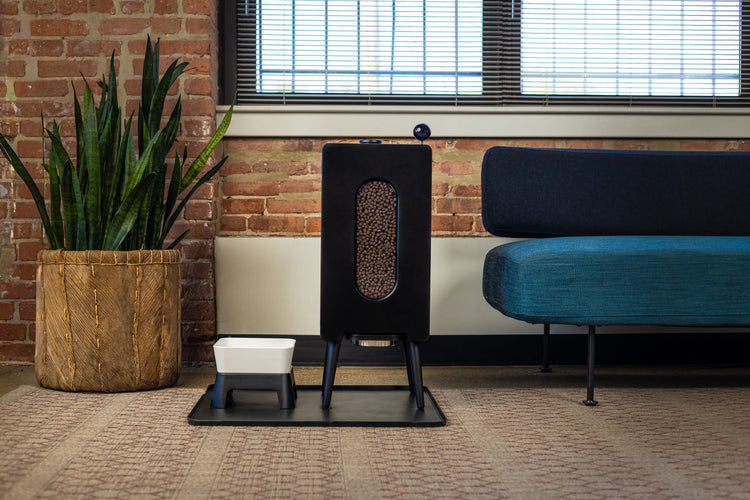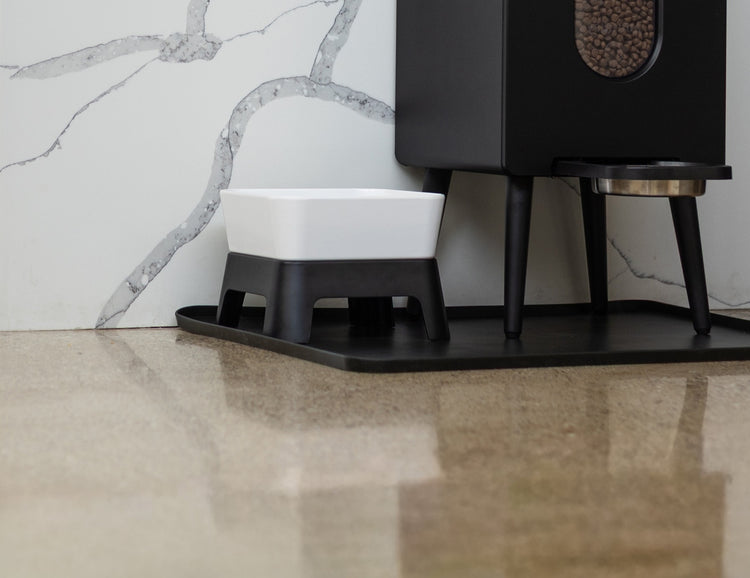How Long Can Dog Kibble Sit Out? Essential Guidelines for Pet Owners
- Houndsy
Table of Contents
- Introduction
- Understanding Kibble and Its Composition
- How Long Can Dog Kibble Sit Out?
- Signs That Kibble Has Gone Bad
- Best Practices for Storing Kibble
- Addressing Common Myths About Kibble Storage
- The Role of the Houndsy Kibble Dispenser
- Case Studies: Real-Life Scenarios
- Conclusion
- FAQ
Introduction
As responsible pet owners, we often find ourselves pondering the crucial question: how long can dog kibble sit out before it becomes unsafe for our furry friends? A recent survey revealed that nearly 80% of dog owners occasionally leave kibble out for extended periods, often without realizing the potential risks involved. This article aims to shed light on the appropriate duration for leaving dry dog food unattended, the factors that influence its safety, and the best practices for storing kibble to maintain its freshness.
By the end of this post, we want you to feel confident in your understanding of proper dog food storage and feeding routines. We'll explore how long kibble can safely remain in your dog's bowl, the signs that indicate it may have gone bad, and effective strategies for ensuring your pet's meals are both nutritious and safe. So, let's dive in and elevate our daily feeding rituals!
Understanding Kibble and Its Composition
Before we determine how long dog kibble can sit out, it's essential to understand what kibble is and its composition. Dry dog food, commonly known as kibble, is a processed food made from a mixture of various ingredients, including:
- Proteins: Meat, fish, or plant-based sources.
- Carbohydrates: Grains, vegetables, or legumes.
- Fats: Animal or plant fats that provide energy and support skin and coat health.
- Vitamins and Minerals: Essential nutrients for overall health.
The processing methods used to create kibble ensure it has a long shelf life, but exposure to air, moisture, and temperature changes can affect its quality. By understanding these components, we can better appreciate how they interact with environmental factors when kibble is left out.
How Long Can Dog Kibble Sit Out?
The general consensus among veterinarians is that dry kibble can safely remain out for up to 8 hours under ideal conditions. However, several factors may influence this timeframe:
- Ambient Temperature: Warmer climates can accelerate the degradation of kibble. In hot and humid conditions, it's advisable to limit the time kibble is left out to 4-6 hours.
- Humidity Levels: Increased moisture in the air can lead to mold growth and spoilage, making it essential to monitor the environment where the kibble is stored or served.
- Quality of Ingredients: Higher quality kibble made with natural ingredients may have a shorter shelf life than those with preservatives.
- Previous Exposure: If kibble has already been opened or exposed to air, it may spoil more quickly than unopened bags.
To ensure your dog's safety, it's better to err on the side of caution. If you're unsure, consider discarding any kibble that has been left out for more than 8 hours.
Signs That Kibble Has Gone Bad
It can be challenging to determine if kibble is still safe for consumption. Here are some key indicators to look for:
- Smell: Fresh kibble has a pleasant, slightly nutty aroma. If it smells rancid or off, it's best to throw it away.
- Texture: Stale kibble loses its crunchiness and may appear soft or crumbly.
- Color Changes: Any discoloration or unusual appearance can signal that the kibble has gone bad.
- Mold: Look for signs of mold, which can manifest as white, gray, or green patches.
- Dog's Reaction: If your dog suddenly refuses to eat kibble they usually enjoy, it could be a sign that the food is no longer palatable.
By keeping an eye out for these signs, we can better protect our pets from potential health issues.
Best Practices for Storing Kibble
Proper storage is key to maintaining the freshness and quality of dog kibble. Here are our top tips:
- Use Airtight Containers: Investing in airtight storage containers helps keep kibble fresh by preventing exposure to air, moisture, and pests. We recommend using a container that can hold a substantial amount of kibble, ideally 25-30 lbs for convenience.
- Keep in a Cool, Dry Place: Store kibble in a cool, dry location, away from direct sunlight and heat sources. This helps preserve its nutritional integrity and flavor.
- Clean the Container Regularly: Periodically wash the storage container to avoid any buildup of bacteria or mold. Ensure it is completely dry before refilling it with kibble.
- Check Expiry Dates: Always pay attention to the expiration dates on the kibble packaging and use the oldest bags first.
- Avoid Free Feeding: Instead of leaving kibble out all day, consider portioning out meals and picking up any uneaten food after a few hours.
By following these best practices, we can ensure that our dogs enjoy safe, fresh, and nutritious meals every day.
Addressing Common Myths About Kibble Storage
As dog owners, we often encounter various myths about kibble and its storage. Let’s debunk a few of them:
Myth 1: Kibble Can Be Left Out All Day
While it might seem convenient, leaving kibble out all day can lead to spoilage and the potential for bacterial growth. It's important to limit the time kibble is left in the bowl to ensure your dog's safety.
Myth 2: Expired Kibble Is Still Safe to Eat
Expired kibble may lose nutritional value and taste, but it can also pose health risks. Always adhere to the expiration dates indicated on the packaging.
Myth 3: All Kibble Is Equal
Not all kibble is created equal. The quality of ingredients and the production process can significantly affect the kibble's shelf life and nutritional content. Opt for high-quality brands that prioritize natural ingredients.
The Role of the Houndsy Kibble Dispenser
At Houndsy, we understand the challenges of maintaining a convenient and visually appealing feeding routine for our pets. Our flagship product, the Houndsy Kibble Dispenser, was designed with these challenges in mind. With its mid-century modern design, ergonomic crank, and perfect portion control, we help make feeding time a delightful experience for both you and your dog.
The Houndsy Kibble Dispenser also features a large storage capacity, able to hold 25-30 lbs of kibble, and a BPA-free liner that keeps food fresh. Plus, its auto-locking mechanism prevents accidental dispensing—an essential feature for curious pets or toddlers. Explore how the Houndsy Kibble Dispenser can elevate your feeding ritual today! Order Now!.
Case Studies: Real-Life Scenarios
To further illustrate the importance of proper kibble management, let’s explore a couple of hypothetical scenarios:
Scenario 1: A Busy Pet Owner
Consider a busy pet owner, Sarah, who often leaves kibble out for her dog, Max, throughout the day. She notices that Max has been refusing to eat his kibble. Upon inspection, Sarah finds that the kibble has a stale smell and texture. By following the guidelines outlined in this article, she realizes that it’s essential to limit how long the kibble sits out and invest in an airtight container to maintain freshness. After implementing these changes, Max happily devours his meals again.
Scenario 2: A Summer Heatwave
During a summer heatwave, James leaves his dog Bella’s kibble out for several hours while he runs errands. When he returns, he finds the kibble has an unpleasant odor and a soft texture. By learning that kibble should not be left out for extended periods in hot weather, James now checks the temperature before leaving food out and ensures it’s stored properly to avoid spoilage.
Conclusion
In summary, understanding how long dog kibble can sit out is crucial for ensuring our pets' health and well-being. By adhering to the 8-hour guideline and being mindful of the conditions in which kibble is stored, we can help prevent spoilage and maintain our dogs’ enthusiasm for mealtime.
Remember to practice good storage habits, recognize the signs of spoiled kibble, and consider investing in innovative products like the Houndsy Kibble Dispenser to simplify and enhance your dog-feeding experience. Order Now!.
FAQ
1. Can I leave kibble out overnight?
It is generally not advised to leave kibble out overnight. If it has been sitting for more than 8 hours, it is better to discard it to ensure your dog’s safety.
2. How can I tell if my kibble has gone bad?
Key signs include an off smell, a change in texture, discoloration, or mold presence. If you’re ever in doubt, it’s safest to discard it.
3. What is the best way to store dry dog food?
Store dry dog food in an airtight container in a cool, dry place, away from sunlight and heat. Regularly clean the container to maintain hygiene.
4. Is it safe for my dog to eat expired kibble?
While expired kibble might not be immediately harmful, it can lose nutritional value and taste. It’s best to avoid feeding your dog expired food.
5. What should I do with uneaten kibble?
If your dog doesn’t finish their kibble within a reasonable timeframe (generally 4-8 hours), discard the leftovers and refill the bowl at the next feeding time.












